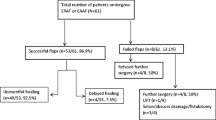Abstract
Background
A retrospective review of 28 patients who had “house flap” anoplasty was carried out to evaluate the therapeutic effectiveness of the procedure.
Methods
House flap anoplasty was performed at Istanbul University Cerrahpasa Medical School, General Surgery Department, in 28 patients over 4 years. Indications were chronic anal fissure, anal stenosis, high transsphincteric fistula, low rectovaginal fistula, anal neoplasia, and obstetric third-degree perineal tear and incontinence. After rectangular excision of the anal or perianal lesion, the “walls” and “roof” of the house flap were incised to the depth of ischiorectal fat. The “base” of this house-shaped flap was then fixed to the top of the excised area.
Results
Median postoperative hospital stay was 4.86 (range = 2–12) days. Postoperative complications included three patients with minimal wound dehiscence and one with rectovaginal fistula recurrence. At a median follow-up of 26.4 (range = 1–46) months, excluding the patient with recurrence, all patients were satisfied with house flap anoplasty.
Conclusion
House advancement flap anoplasty is a relatively simple procedure, combining the beneficial features of rectangular flaps and V-Y plasties. It can be used in nearly all types of anoderm deficiencies with a high rate of success and patient satisfaction.



Similar content being viewed by others
References
Angelchik PD, Harms BA, Starling JR (1993) Repair of anal stricture and mucosal ectropion with Y-V or pedicle flap anoplasty. Am J Surg 166:55–59
Christensen MA, Pitsch RM Jr, Cali RL et al (1992) “House” advancement pedicle flap for anal stenosis. Dis Colon Rectum 35:201–203
Khubchandani IT (1994) Anal stenosis. Surg Clin North Am 74:1353–1360
Jorge JMN, Wexner SD (1993) Etiology and management of fecal incontinence. Dis Colon Rectum 36:77–97
Pla-Marti V, Moro-Valdezate D, Alos-Company R et al (2007) The effect of surgery on quality of life in patients with fecal incontinence of obstetric origin. Colorectal Dis 9:90–95
Sentovich SM, Falk PM, Christensen MA et al (1996) Operative results of House advancement anoplasty. Br J Surg 83:1242–1244
Maria G, Brisinda G, Civello IM (1998) Anoplasty for the treatment of anal stenosis. Am J Surg 175:158–160
Khubchandani M (1988) Results of modified Martin anoplasty. N Y State J Med 88:35–36
Khubchandani IT (1985) Mucosal advancement anoplasty. Dis Colon Rectum 28:194–196
Robertson WG, Mangione JS (1998) Cutaneous advancement flap closure: alternative method for treatment of complicated anal fistulas. Dis Colon Rectum 41:884–886, discussion 886-887
Lagares-Garcia JA, Nogueras JJ (2002) Anal stenosis and mucosal ectropion. Surg Clin North Am 82:1225–1231
Caplin DA, Kodner IJ (1986) Repair of anal stricture and mucosal ectropion by simple flap procedures. Dis Colon Rectum 29:92–94
Pearl RK, Hooks VH III, Abcarian H et al (1990) Island flap anoplasty for the treatment of anal stricture and mucosal ectropion. Dis Colon Rectum 33:581–583
Zimmerman DD, Briel JW, Gosselink MP et al (2001) Anocutaneous advancement flap repair of transsphincteric fistulas. Dis Colon Rectum 44:1474–1480
Ellis CN, Clark S (2006) Fibrin glue as an adjunct to flap repair of anal fistulas: a randomized, controlled study. Dis Colon Rectum 49:1736–1740
Shelton AA, Welton ML (2006) Transperineal repair of persistent rectovaginal fistulas using an acellular cadaveric dermal graft (AlloDerm). Dis Colon Rectum 49:1454–1457
Kodner IJ, Mazor A, Shemesh EI, Fry RD et al (1993) Endorectal advancement flap repair of rectovaginal and other complicated anorectal fistulas. Surgery 114:682–690
Ellis CN, Clark S (2007) Effect of tobacco smoking on advancement flap repair of complex anal fistulas. Dis Colon Rectum 50:459–463
Amin SN, Tierney GM, Lund JN et al (2003) V-Y advancement flap for treatment of fistula-in-ano. Dis Colon Rectum 46:540–543
Leong AF, Seow-Choen F (1995) Lateral sphincterotomy compared with anal advancement flap for chronic anal fissure. Dis Colon Rectum 38:69–71
Kenefick NJ, Gee AS, Durdey P (2002) Treatment of resistant anal fissure with advancement anoplasty. Colorectal Dis 4:463–466
Olsha O, Mintz A, Gimon Z et al (2005) Anal melanoma in the era of sentinel lymph node mapping: a diagnostic and therapeutic challenge. Tech Coloproctol 9:60–62
Bernardi C, Pescatori M (2000) Double “house” cutaneous flap, post anal repair and rectal mucosal advancement for a non-healing post-haemorrhoidectomy wound with faecal incontinence. A temporary diverting sigmoidostomy was also performed. Tech Coloproctol 4:78
Acknowledgment
We dedicate this article to our honorable and precious colleague and master Professor Ismail Aydemir who passed away last year.
Author information
Authors and Affiliations
Corresponding author
Rights and permissions
About this article
Cite this article
Alver, O., Ersoy, Y.E., Aydemir, I. et al. Use of “House” Advancement Flap in Anorectal Diseases. World J Surg 32, 2281–2286 (2008). https://doi.org/10.1007/s00268-008-9699-1
Published:
Issue Date:
DOI: https://doi.org/10.1007/s00268-008-9699-1




